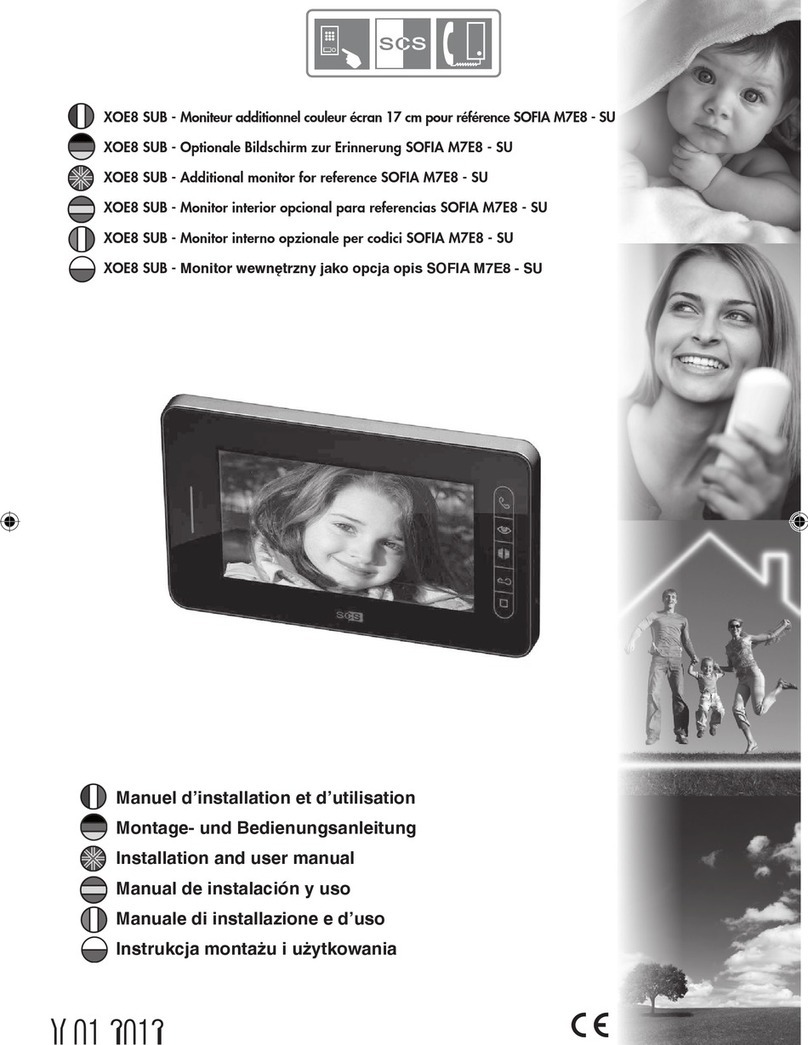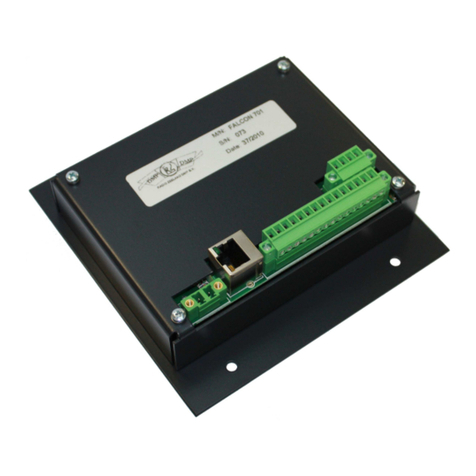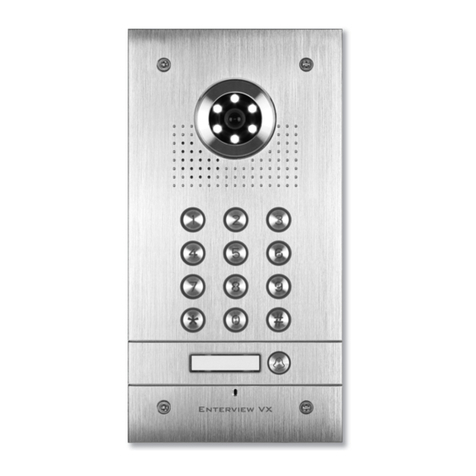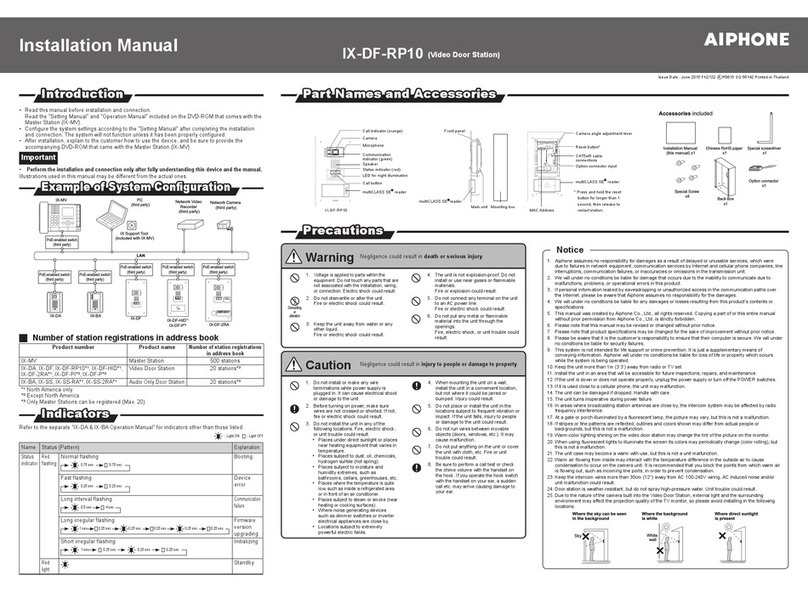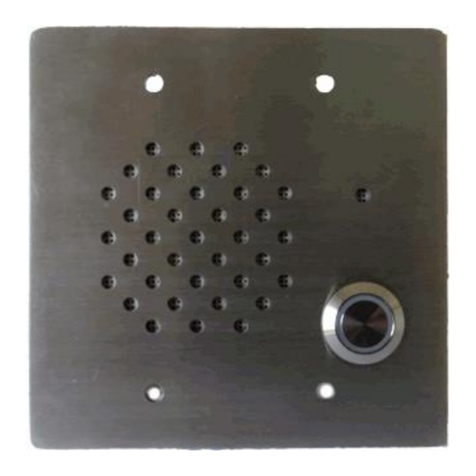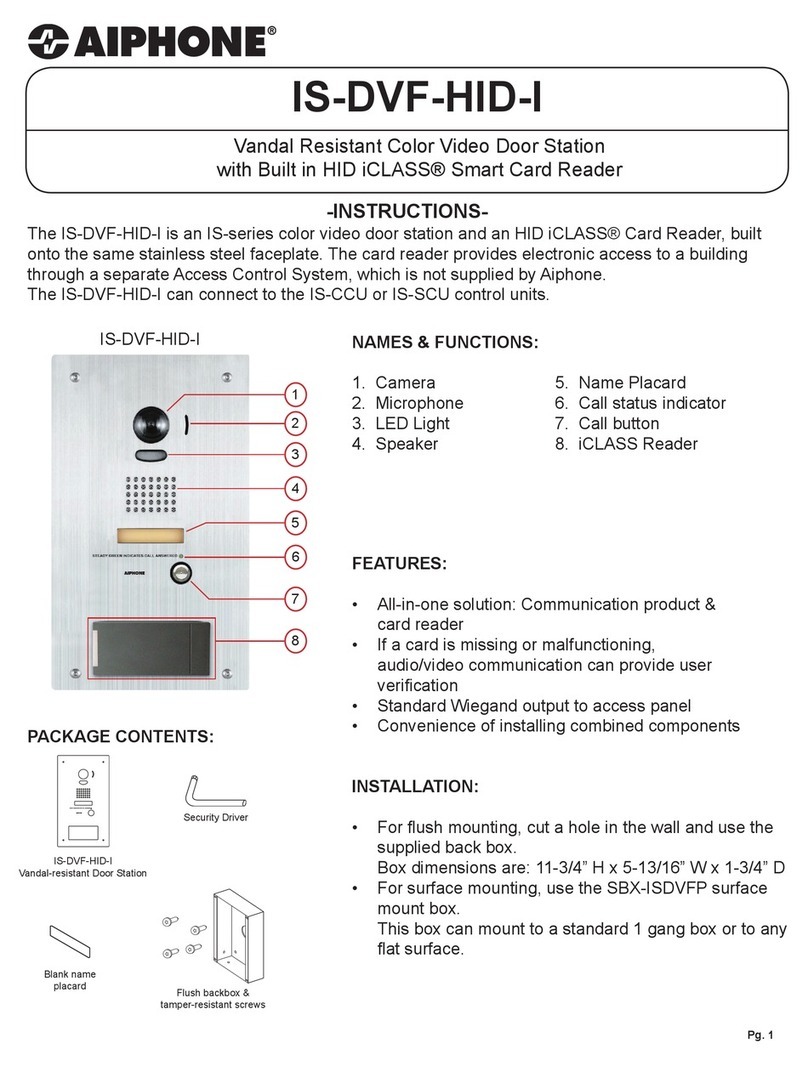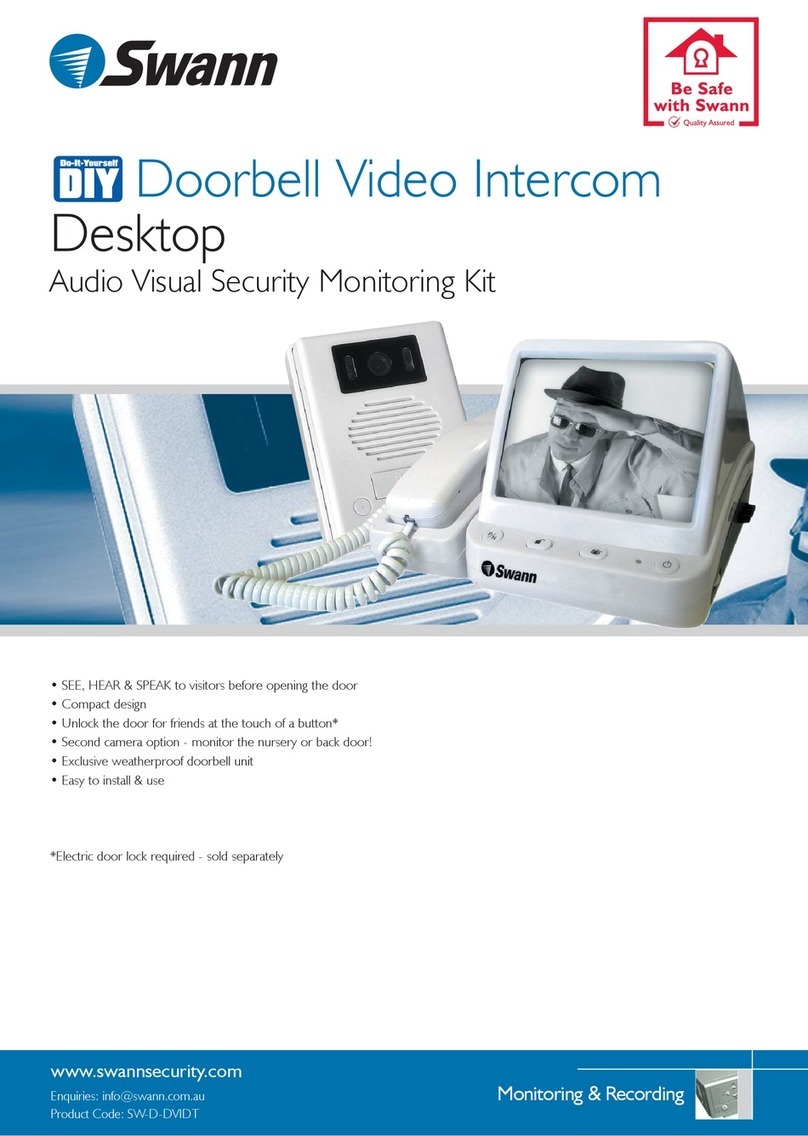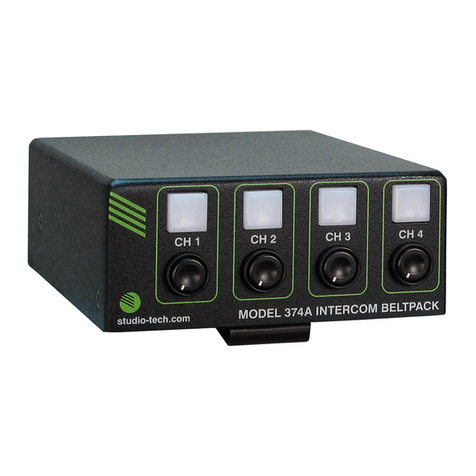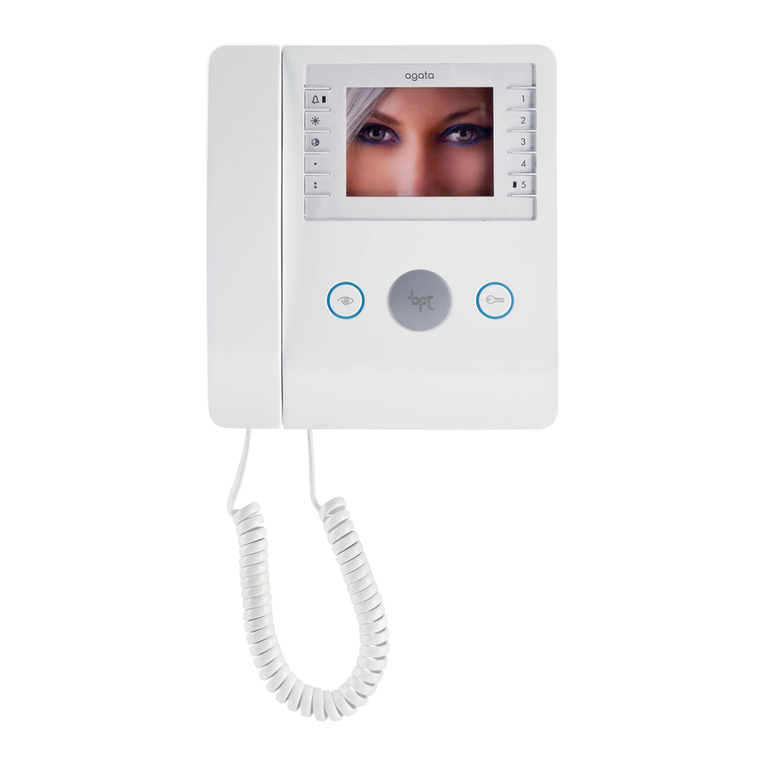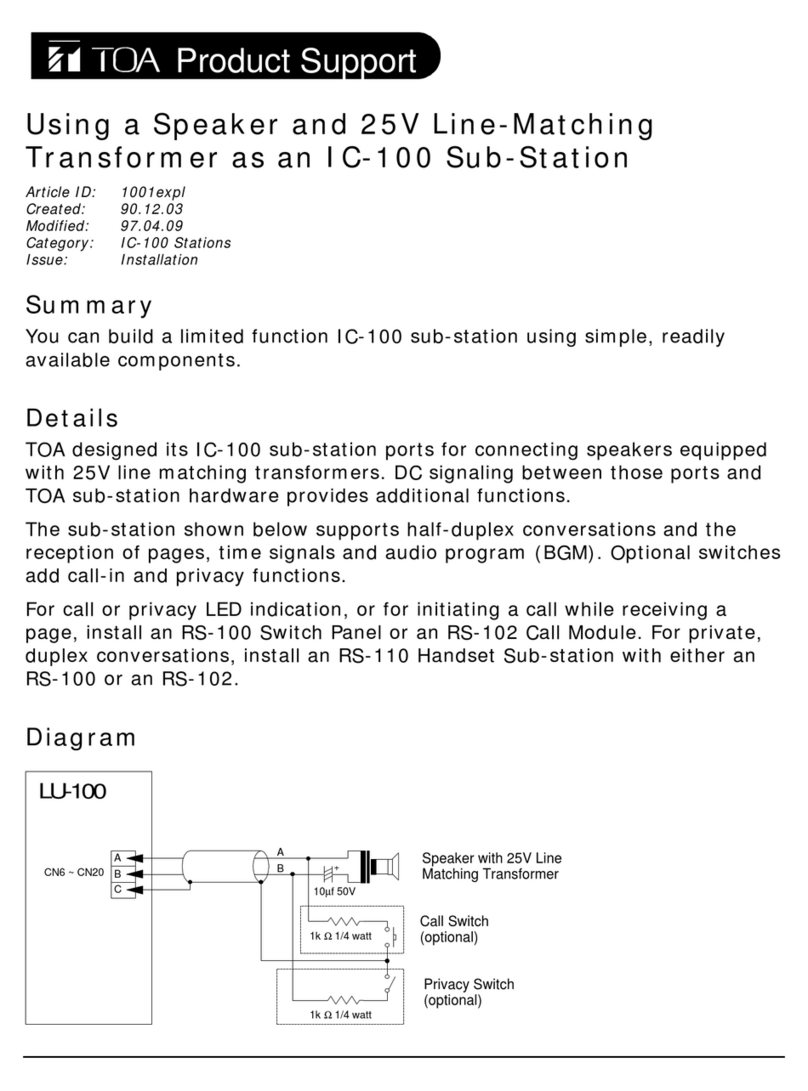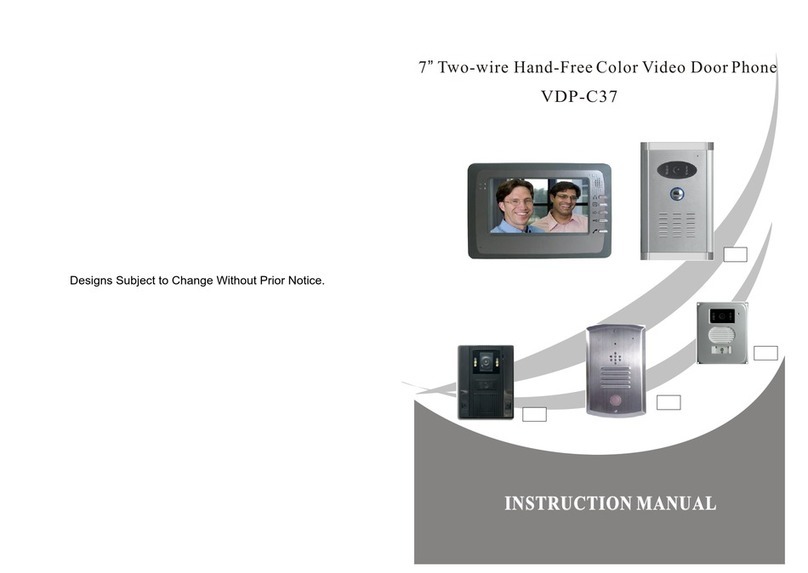Bitron AV1407/7 User manual

LBT 90325DS901407-001
CITOFONO T-LINE
T-LINE DOOR PHONE
INTERPHONE T-LINE
AV1407/7
MANUEL D’INSTRUCTIONS
CARATERISTIQUES DE FONCTIONNEMENT ET INSTALLATION
INSTRUCTIONS MANUAL
OPERATING AND INSTALLATION FEATURES
MANUALE ISTRUZIONI
CARATTERISTICHE DI FUNZIONAMENTO E INSTALLAZIONE

2DS901407-001 DS901407-001 3
ITALIANO
INSTALLAZIONE
Togliere la cappa del citofono.
Fissare la base a parete con le viti e i tasselli forniti a corredo.
Configurare gli switch di programmazione ed eseguire i collegamenti.
Rimontare la cappa.
1,48 ÷ 1,52 m
DESCRIZIONE DEI MORSETTI
BUS
}
Linea Bus
BUS
P
}
Chiamata al piano
P
S+
}
Suoneria supplementare
S-
CONFIGURAZIONE
= =
ON
ON
INT
ON
21
CODE
ON
43215876
Valori default: tutti i citofoni escono di fabbrica configurati nel seguente modo:
UTENTE= 127
INTERNO= 0
In questo modo, per il corretto funzionamento dell’impianto è sempre necessario porre attenzione ai dip-
switch per impostarli al valore corretto.
Per le impostazioni dei dip-switch fare riferimento al libretto di sistema fornito a corredo dell’alimentatore
AV1001/02.
•
•
•
•
CODE: codice utente.
Impostare un numero da 0 a 127 secondo le regole seguenti:
Nella colonna non ci devono essere appartamenti diversi con lo stesso codice utente.
Nel caso di posti interni in parallelo nello stesso appartamento, questi devono avere lo stesso codice
utente.
I codici utente di una stessa colonna devono essere consecutivi.
Per impostare il codice desiderato utilizzare i dip-switch CODE da 2 a 8 (2= bit più significativo - 8= bit
meno significativo); il dip-switch 1 deve essere OFF.
INT: codice dell’interno dell’appartamento.
Impostare un numero da 0 a 3 secondo le regole seguenti:
Nel caso di un solo posto interno presente nell’appartamento, il codice dell’interno deve essere impostato
a 0.
Negli appartamenti è possibile collegare fino a 4 posti interni in parallelo tutti con stesso codice utente ma
con codici interni differenti.
Il codice dell’interno serve ad identificare i singoli posti interni dello stesso utente. Questo permette di
effettuare chiamate intercomunicanti indirizzate al singolo interno nell’ambito dello stesso appartamento.
Nel caso di chiamate intercomunicanti ad appartamenti differenti, nel caso di chiamate provenienti da posti
esterni e nel caso di chiamata al piano, squillano sempre tutti i posti interni dell’utente. Occorre tenere
presente che l’interno 0, alla ricezione della chiamata, squilla subito; gli interni 1, 2 e 3 squillano in sequenza
uno dopo l’altro.
IMPOSTAZIONE DELLE TERMINAZIONI DI LINEA
ON
12345 12
ON
Terminazione linea
OFF ON
Sul citofono è presente un jumper che permette di inserire la terminazione di linea. È necessario attivare la
terminazione in tutti i dispositivi cablati alla fine di una linea che non riparte con un’altra tratta dagli stessi
morsetti del dispositivo stesso (fine linea):
Terminazione
ON
Terminazione
OFF
BUS OUT
BUS IN
BUS 1
BUS 3
BUS 4 BUS 2
Terminazione
ON
BUS 1BUS 3
BUS 4 BUS 2
Terminazione
ON
BUS OUT
BUS IN
•
•
•
•
•

4DS901407-001 DS901407-001 5
PRESTAZIONI
RICEZIONE DELLE CHIAMATE
Alla ricezione di una chiamata, il posto interno dell’utente squilla con la melodia impostata a seconda della
provenienza:
Da postazione di chiamata principale
Da postazione di chiamata secondaria
Intercomunicante
Al piano
Da centralino
Dalla ricezione della chiamata, è sempre possibile pilotare l’attivazione dell’elettroserratura della postazione di
chiamata anche senza sganciare il microtelefono.
Se nell’appartamento ci sono più posti interni in parallelo, l’interno 0 squilla subito; immediatamente dopo,
squillano gli interni 1, 2 e 3 in sequenza uno dopo l’altro.
INOLTRO DELLE CHIAMATE INTERCOMUNICANTI
Dopo avere programmato un pulsante per la funzione intercomunicante, sganciare il microtelefono e premere il
pulsante. Possono verificarsi i seguenti casi in funzione dello stato del posto interno chiamante:
Posto interno libero: il posto interno chiamante emette un tono di conferma (2 bip) e il posto interno
chiamato squilla. Allo sgancio del chiamato si entra in comunicazione.
Posto interno occupato: il posto interno emette un tono di dissuasione (4 bip veloci). Riagganciare e
riprovare in seguito.
FUNZIONE CHIAMATA AL PIANO
Il citofono è dotato di una coppia di morsetti (P) per il collegamento del pulsante di chiamata al piano. Alla
pressione del pulsante, il posto interno emette uno squillo della durata di 3s con una melodia diversa dalla
chiamata citofonica. Se l’utente ha più posti interni in parallelo, connettere tale pulsante solo su un posto
interno. Gli interni squilleranno in sequenza.
GESTIONE SONERIA SUPPLEMENTARE
Il citofono è dotato di una coppia di morsetti (S-, S+) per il collegamento di una soneria supplementare o di un
relè. Tale soneria viene pilotata contemporaneamente alla generazione di qualsiasi squillo di chiamata.
REGOLAZIONE VOLUME DI CHIAMATA
Con il selettore in posizione superiore si imposta il massimo volume della suoneria; con il selettore in posizione
intermedia si ha il minimo volume e con selettore in posizione inferiore, si esclude completamente la suoneria.
Quest’ultima posizione è evidenziata dalla fuoriuscita dal fondo del citofono di una bandierina segnalazione
di colore rosso.
•
•
•
•
•
•
•
FUNZIONI PULSANTI
STATO
PULSANTE
RIPOSO E
AGGANCIATO ATTESA SGANCIO
(ricezione
chiamata)
IN FONIA RIPOSO E
SGANCIATO
PULSANTE Apriporta
passo carraio Apriporta
passo carraio Apriporta
passo carraio Chiamata intercomunicante 3
programmabile
(default: non programmato)
Apriporta
pedonale Apriporta
pedonale Apriporta
pedonale Apriporta
pedonale
PULSANTE
AGGIUNTIVO 1÷5
AV1407/051
Funzione
speciale 2÷6 Funzione
speciale 2÷6 Funzione
speciale 2÷6 Chiamata intercomunicante 4÷8
programmabile
(default: non programmato)
AGGIUNTIVO
AV1407/051
Apriporta
automatico Apriporta
automatico Apriporta
automatico Apriporta automatico
PROGRAMMAZIONI OPZIONALI PER PRESTAZIONI AGGIUNTIVE
Dopo aver verificato il funzionamento base del sistema, solo se sono richieste le seguenti funzioni, è necessario
effettuare le opportune operazioni di programmazione.
FUNZIONE INTERCOMUNICANTE SU POSTO INTERNO
Nel sistema B-Twin è possibile programmare alcuni pulsanti per la funzione di chiamata intercomunicante.
Un pulsante può essere programmato per chiamare un altro utente della colonna oppure per chiamare un posto
interno in parallelo. Nel primo caso, squillano tutti i posti interni dell’utente chiamato; nel secondo caso,
squilla solo il posto interno specificato in programmazione.
FUNZIONE INTERCOMUNICANTE FRA UTENTI DIVERSI
Recarsi presso il posto interno da programmare come chiamante (posto interno A).
Tenendo premuto il pulsante apriporta, sganciare il microtelefono. Il posto interno A emette un tono ad
indicare l’ingresso in programmazione.
‘a’
BEEP!
Premere il pulsante da programmare; il posto interno emette un tono di conferma.
‘a’
BEEP!
•
•
•

6DS901407-001 DS901407-001 7
Recarsi presso l’utente che quel pulsante dovrà chiamare (utente B) e premere il pulsante apriporta. I posti
interni emettono un bip di avvenuta programmazione.
Oppure, recarsi presso una postazione di chiamata e premere il pulsante di chiamata dell’utente B; il posto
interno in programmazione (A) emette un bip di avvenuta programmazione. In concomitanza di questa
operazione, i posti interni dell’utente B squillano. Trascurare questa chiamata.
‘b’
BEEP!
Riagganciare il microtelefono del posto interno A che emette un bip di uscita dalla programmazione.
Verificare la funzione programmata: sganciare il microtelefono A e premere il pulsante programmato.
Verificare lo squillo di tutti i posti interni dell’utente B e la fonia.
Se si vuole anche programmare la chiamata inversa, è necessario programmare anche il posto interno B per
la chiamata ad A.
Se si programmano i pulsanti per questa funzione, non vengono perse le altre prestazioni indicate nella
tabella “Funzioni pulsanti” in quanto la chiamata intercomunicante viene effettuata a microtelefono
sganciato.
FUNZIONE INTERCOMUNICANTE NELLO STESSO APPARTAMENTO
Recarsi presso il posto interno da programmare come chiamante (posto interno C1).
Tenendo premuto il pulsante apriporta, sganciare il microtelefono. Il posto interno C1 emette un tono ad
indicare l’ingresso in programmazione pulsanti.
‘c1’
BEEP!
Premere il pulsante da programmare; il posto interno C1 emette un tono di conferma.
‘c1’
BEEP!
Recarsi presso il posto interno che quel pulsante dovrà chiamare (posto interno C2) e premere il pulsante
apriporta. I posti interni C1 e C2 emettono un bip di avvenuta programmazione.
•
•
•
•
•
•
•
•
‘c2’
BEEP!
Riagganciare il microtelefono del posto interno C1 che emette un bip di uscita dalla programmazione.
Verificare la funzione programmata: sganciare il microtelefono C1 e premere il pulsante programmato.
Verificare lo squillo del posto interno C2 e la fonia.
Se si vuole anche programmare la chiamata inversa, è necessario programmare anche il posto interno C2 per
la chiamata a C1.
Se si programmano i pulsanti per questa funzione, non vengono perse le altre prestazioni indicate nella
tabella “Funzioni pulsanti” in quanto la chiamata intercomunicante viene effettuata a microtelefono
sganciato.
MELODIA DI CHIAMATA CITOFONICA
Nei posti interni del sistema B-Twin, si può scegliere fra 5 melodie di chiamata. La scelta delle melodie può
essere effettuata anche dall’utente finale con queste semplici sequenze.
Tenendo premuto il pulsante apriporta, premere e rilasciare il pulsante . Il posto interno emette uno squillo
con una melodia.
Sempre mantenendo premuto il pulsante apriporta, ripremere il pulsante per cambiare melodia.
Quando si trova la melodia desiderata, rilasciare il pulsante apriporta. La melodia è programmata.
MELODIA DI CHIAMATA AL PIANO
Questa programmazione è possibile solo sui citofoni equipaggiati con aggiuntivo tasti AV1407/051.
Nei posti interni del sistema B-Twin, si può scegliere fra 5 melodie di chiamata al piano. La scelta delle melodie
può essere effettuata anche dall’utente finale con queste semplici sequenze.
Tenendo premuto il pulsante apriporta, premere e rilasciare il pulsante 1 dell’aggiuntivo 1407/051. Il posto
interno emette uno squillo con una melodia.
Sempre mantenendo premuto il pulsante apriporta, ripremere il pulsante 1 dell’aggiuntivo 1407/051 per
cambiare melodia.
Quando si trova la melodia desiderata, rilasciare il pulsante apriporta. La melodia è programmata.
1
2
3
4
5
6
•
•
•
•
•
•
•
•

8DS901407-001 DS901407-001 9
CANCELLAZIONE DEI DATI DI PROGRAMMAZIONE
Per cancellare tutti i dati di programmazione opzionali (codici di chiamata intercomunicante), eseguire le
seguenti operazioni:
Tenendo premuto il pulsante apriporta, sganciare il microtelefono
Premere contemporaneamente i tasti e e tenerli premuti per 3 secondi fino all’emissione di un tono
di avvenuta cancellazione.
Rilasciare i tasti e e riagganciare il microtelefono.
La procedura di cancellazione non cambia le melodie di chiamata che sono state impostate.
CARATTERISTICHE TECNICHE
Tensione di alimentazione:.................................................................................................. 36 ÷ 48Vdc
Assorbimento a riposo: ....................................................................................................... 3,0mA max
Assorbimento max:.............................................................................................................. 70mA max
Temperatura di funzionamento:......................................................................................... -5°C ÷ +45°C
Conformità normativa:................................................................................ EN 61000-6-3, EN 61000-6-1
•
•
•
ENGLISH
INSTALLATION
Remove the door phone hood.
Fix the base to the wall with the screws and bolts included.
Configure the programming switches and make the connections.
Refit the hood.
1,48 ÷ 1,52 m
DESCRIPTION OF TERMINALS
BUS
}
Bus line in
BUS
P
}
Floor call
P
S+
}
Supplementary ringer
S-
CONFIGURATION
= =
ON
ON
INT
ON
21
CODE
ON
43215876
Default settings: default indoor station settings are:
USER= 127
INDOOR STATION= 0
The dip switches must always be arranged in the correct setting for correct operation of the system in this
case.
Refer to the system booklet provided with the power unit AV1001/02 for dip switch settings.
•
•
•
•

10 DS901407-001 DS901407-001 11
CODE: user code.
Set a number from 0 to 127 according to the following rules:
No two apartments in the system can have the same user code.
Indoor stations in parallel in the same apartment must have the same user code.
User codes be consecutive in the same column must.
Use the CODE dip switches from 2 to 8 (2= most significant bit - 8= least significant bit) to set the required
code. Dip switch 1 must be OFF.
INT: apartment station code.
Set a number from 0 to 3 according to the following rules:
The indoor station code must be 0 if there is only one station in the apartment.
Up to 4 apartment stations can be connected in parallel using the same user code and different indoor
station codes.
The indoor station code is used to identify the single stations of the same user. This means that intercom calls
can be address to the single user in the same apartment. All the users indoor stations will ring at the same
time in the event of intercom calls to different apartments, door unit calls and floor calls. Extension 0 rings
immediately when a call is received. Extensions 1, 2 and 3 will ring in sequence after each other.
LINE TERMINAL SETTINGS
ON
12345 12
ON
Line termination
OFF ON
A line terminal jumper is fitted in the door phone. Activate the terminal for devices wired at the end of a line
from which another section does not start from the device terminals (end of line):
Termination
ON
Termination
OFF
BUS OUT
BUS IN
BUS 1
BUS 3
BUS 4 BUS 2
Termination
ON
BUS 1BUS 3
BUS 4 BUS 2
Termination
ON
BUS OUT
BUS IN
•
•
•
•
•
PERFORMANCE
CALL RECEPTION
The user’s apartment station will ring with the programmed tone when a call is received according to the
source:
From main door unit
From secondary door unit
Intercom call
Floor calls
From switchboard
From reception of the call, it is always possible to activate the electric lock of the call station also without
lifting the handset.
Indoor station 0 will ring immediately if there are several stations in the apartment. Extensions 1, 2 and 3 will
ring in sequence after each other.
INTERCOM CALL FORWARDING
After programming the button for the intercom function, pickup the handset and press the button.
The following cases can occur according to the calling indoor station state:
Indoor station free: the calling indoor station will output a confirmation tone (2 beeps) and the called
indoor station will ring. Communication is established when the called user picks up.
Indoor station busy: the indoor station outputs a warning tone (4 beeps in rapid sequence). Hang up and
try again later.
FUNZIONE CHIAMATA AL PIANO
The door phone is equipped with a pair of terminals (P) for connection of the call to floor button. When the
button is pressed, the internal station emits a 3s long ring with a different tune from the door phone call.
Connect this button only to one indoor station if there are several indoor stations in parallel. Extensions 1, 2
and 3 will ring in sequence after each other.
GESTIONE SONERIA SUPPLEMENTARE
The door phone is equipped with a pair of terminals (S-, S+) for connecting a supplementary ringer or a relay.
This ringer is controlled when any call tone is generated.
ADJUSTING CALL VOLUME
When the selector is in the upper position the maximum ringer volume is set; with the selector in middle
position the minumum ringer volume is set and with the selector in the lowest position the ringer is completely
excluded. This last position is signalled by a little red flag, that appears at the bottom of the door phone.
•
•
•
•
•
•
•

12 DS901407-001 DS901407-001 13
BUTTONS FUNCTIONS
STATE
BUTTON
STAND-BY AND
ON HOOK WAITING FOR
PICK-UP
(receiving a call)
AUDIO STAND-BY
AND OFF-HOOK
BUTTON Garage door
lock release Garage door lock
release Garage door
lock release Programmable intercom call 3
(Default: not programmed)
Door lock
release Door lock
release Door lock
release Door lock
release
ADDITIONAL
BUTTON 1÷5
AV1407/051
Special
function 2÷6 Special
function 2÷6 Special
function 2÷6 Programmable intercom call
4÷8 (Default: not programmed)
ADD-ON
AV1407/051
Automatic door
lock release Automatic door lock
release Automatic
door lock
release
Automatic door lock release
OPTIONAL PROGRAMMING FOR ADDITIONAL FUNCTIONS
The following programming operations are needed after testing the basic operation of the system, only if are
required.
INDOOR STATION INTERCOM FUNCTION
In the B-Twin system, various buttons can be programmed for the intercom call function.
One button can be programmed to call another user in the column or to call an indoor station in parallel. All
indoor stations of the called user will ring in the first case. Only the specifically programmed indoor station
will ring in the second case.
INTERCOM FUNCTION BETWEEN VARIOUS USERS
Go to the indoor station to be programmed as caller (indoor station A).
Hold the door opener button pressed and pick up the handset. The indoor station A outputs a tone to
indicate that programming mode is in progress.
‘a’
BEEP!
Press the button to be programmed. The indoor station will output a confirmation tone.
‘a’
BEEP!
•
•
•
Go to the user that the button will call (user B) and press the door opener button. The indoor stations will
be beep to indicate that they have been programmed.
Alternatively, go to a calling station and press the calling button of user B. The indoor station being
programming (A) will beep to indicate that it has been programmed. The indoor stations of user B will ring
when this occurs. Ignore this call.
‘b’
BEEP!
Hook up the handset of indoor station A. It will beep to indicate exit from programming mode.
Check programmed function: release the handset A and press the programmed button. Check that all indoor
stations of user B ring and check audio.
You will need to program indoor station B to call A to make the opposite call possible.
The other functions listed in the “Buttons functions” table will not be lost if the buttons are programmed
for this function because the intercom call is made with the handset off-hook.
INTERCOM FUNCTION IN THE SAME APARTMENT
Go to the apartment station to be programmed as caller (indoor station C1).
Hold the door opener button pressed and pick up the handset. The indoor station C1 outputs a tone to
indicate that programming is in progress.
‘c1’
BEEP!
Press the button to be programmed. The indoor station C1 will output a confirmation tone.
‘c1’
BEEP!
Go to the indoor station that the button will call (apartment station C2) and press the door opener button.
The indoor stations C1 and C2 will be beep to indicate that they have been programmed.
•
•
•
•
•
•
•
•

14 DS901407-001 DS901407-001 15
‘c2’
BEEP!
Hook up the handset of indoor station C1. It will beep to indicate exit from programming mode.
Check programmed function: pick up the handset C1 and press the programmed button. Check that the
indoor station C2 rings and check audio.
You will need to program indoor station C2 to call C1 to make the opposite call possible.
The other functions listed in the “Button functions” table will not be lost if the buttons are programmed
for this function because the intercom call is made with the handset off-hook.
DOOR PHONE CALL TONE
Five tones can be selected on B-Twin system indoor stations. The tones can be programmed also by the end
user by following the simple sequence below.
Hold the door opener button pressed. Press and release the button . The indoor station will play a tone.
Hold the door opener button pressed and press the button again to change the tone.
Release the door opener button when you have chosen the tone you want. The tone is now programmed.
FLOOR CALL TONE
Programming is possible only on door phones equipped with key add-on AV1407/051.
Five floor call tones can be selected on B-Twin system indoor stations. The tones can be programmed also by
the end user by following the simple sequence below.
Holding down the door-release button, press and release button 1 of the add-on 1407/051. The indoor
station will play a tone.
Continuing to hold down the door-release button, press button 1 of the add-on 1407/051 again to change
tune.
Release the door opener button when you have chosen the tone you want. The tone is now programmed.
1
2
3
4
5
6
•
•
•
•
•
•
•
•
•
PROGRAMMING DATA DELETION
Proceed as follows to delete all optional programming data (intercom calling code):
Hold the door opener button pressed and pick up the handset.
Press and at the same time for 3 seconds until you hear the deletion tone.
Release buttons and and hang up.
The deletion procedure will not change the programmed calling tones.
TECHNICAL SPECIFICATIONS
Power voltage: .................................................................................................................. 36 ÷ 48Vdc
Stand-by consumption:....................................................................................................... 3,0mA max
Max. consumption:.............................................................................................................. 70mA max
Working temperature range: ............................................................................................. -5°C ÷ +45°C
Reference standards: .................................................................................. EN 61000-6-3, EN 61000-6-1
•
•
•

16 DS901407-001 DS901407-001 17
FRANÇAIS
INSTALLATION
Enlever le couvercle de l’interphone.
Fixer la base à la paroi avec les vis et les chevilles livrées.
Configurer les dip-switch de programmation et effectuer les branchements.
Remonter le couvercle.
1,48 ÷ 1,52 m
DESCRIPTION OF TERMINALS
BUS
}
Ligne BUS
BUS
P
}
Appel à l’étage
P
S+
}
Sonnerie supplémentaire
S-
CONFIGURATION
= =
ON
ON
INT
ON
21
CODE
ON
43215876
Valeurs implicites: tous les interphones sont configurés en usine de la façon suivante:
UTILISATEUR= 127
CODE INTERNE= 0
Ainsi, pour le bon fonctionnement du système, il faut toujours faire attention aux dip switches pour les
configurer avec la valeur correcte.
Pour les configurations des dip-switches se référer au manuel du système livré avec l’alimentation
AV1001/02.
•
•
•
•
CODE: code utilisateur.
Saisir un numéro compris entre 0 et 127 en fonction des règles suivantes:
La colonne ne doit pas comprendre d’appartements différents ayant le même code utilisateur.
En cas de postes internes en parallèle dans le même appartement, ceux-ci doivent avoir le même code
utilisateur.
Les codes utilisateur de la même colonne doivent être consécutifs.
Pour saisir le code souhaité, utiliser les micro-interrupteurs CODE de 2 à 8 (2= bit plus significatif - 8= bit
moins significatif); le micro-interrupteur 1 doit être en position OFF.
INT: code du poste interne de l’appartement.
Saisir un nombre compris entre 0 et 3 conformément aux règles suivantes:
Si un seul poste interne est présent dans l’appartement, le code du poste interne doit être égal à 0;
Dans les appartements, il est possible de brancher jusqu’à un maximum de 4 postes internes en parallèle,
ayant tous le même code utilisateur, mais avec des codes internes différents.
Le code du poste interne sert à identifier les différents postes internes d’un même utilisateur. Cela permet
d’effectuer des appels intercom adressés à un poste interne donné, à l’intérieur du même appartement.
En cas d’appels intercom vers des appartements différents ou d’appels en provenance de postes d’appel et en
cas d’appel à l’étage, tous les postes internes de l’utilisateur sonnent. Il faut tenir compte que le code interne
0, à la réception de l’appel, sonne immédiatement; les codes internes 1, 2 et 3 sonnent en séquence, l’un
après l’autre.
CONFIGURATION DES TERMINAISONS DE LIGNE
ON
12345 12
ON
Terminaison ligne
OFF ON
Sur l’interphone il y a un pontet qui permet d’activer la terminaison de ligne. Il faut activer la terminaison
dans tous les dispositifs câblés à l’extrémité d’une ligne qui ne repart pas avec un autre segment des bornes
du dispositif même (fin de la ligne):
Terminaison
ON
Terminaison
OFF
BUS OUT
BUS IN
BUS 1
BUS 3
BUS 4 BUS 2
Terminaison
ON
BUS 1BUS 3
BUS 4 BUS 2
Terminaison
ON
BUS OUT
BUS IN
•
•
•
•
•

18 DS901407-001 DS901407-001 19
PERFORMANCES
RÉCEPTION DES APPELS
Lors de la réception d’un appel, le poste interne de l’utilisateur sonne avec la tonalité configurée selon sa
provenance:
Depuis le poste externe principal
Depuis le poste externe secondaire
Intercom
A l’étage
Depuis la centrale
Dès réception d’un appel, il est toujours possible de déclencher l’activation de la serrure électrique du poste,
même sans décrocher le microtéléphone.
Si dans l’appartement il y a plusieurs codes internes en parallèle, le code interne 0 sonne tout de suite, les
codes internes 1, 2 et 3 sonnent immédiatement après, en séquence l’un après l’autre.
ENVOI DES APPELS INTERCOM
Après avoir programmé une touche pour la fonction intercom, décrocher le combiné et appuyer sur la touche.
Les cas suivants peuvent se présenter, en fonction de l’état du poste interne appelant:
Poste interne libre: le poste interne appelant émet une tonalité de confirmation (2 bip) et le poste interne
appelé sonne. Quand l’appelé décroche le combiné, les deux postes entrent en communication.
Poste interne occupé: le poste interne émet une tonalité de dissuasion (4 bip en succession rapide).
Raccrocher le combiné et retenter plus tard.
FONCTION APPEL A L’ETAGE
L’interphone est équipé de deux bornes (P) de branchement du bouton d’appel à l’étage. Dès que le bouton
est enfoncé, le poste interne émet une sonnerie pendant 3 s dont la mélodie est différente de l’appel par
l’interphone.
Si l’utilisateur comporte plusieurs postes internes en parallèle, brancher cette touche uniquement sur le poste
interne. Les postes internes sonneront en séquence.
SONNERIE SUPPLEMENTAIRE
Les postes internes sont munis d’une paire de bornes (S+, S-) pour le raccordement d’une sonnerie supplémentaire
ou d’un relais. Cette sonnerie est pilotée simultanément à l’émission d’une quelconque tonalité d’appel.
REGLAGE DU VOLUME DE L’APPEL
Si le sélecteur est en position supérieure on programme le volume maximal de la sonnerie; avec le sélecteur en
position intermédiaire on programme le volume minimal et avec le sélecteur en position inférieure la sonnerie
est complètement exclue. Cette dernière position est indiquée par la sortie du fond de l’interphone d’un petit
drapeau rouge de signalisation.
•
•
•
•
•
•
•
FONCTIONS DES TOUCHES
ÉTAT
TOUCHE
REPOS ET
RACCROCHÉ ATTENTE
DÉCROCHAGE
(réception appel)
PHONIE
ACTIVE REPOS ET
DÉCROCHÉ
BUTTON Ouvre-porte
sortie des
voiture
Ouvre-porte sortie
des voiture Ouvre-porte
sortie des
voiture
Appel intercom 3 programmable
(implicite: non programmé)
Ouvre-porte
passage piéton Ouvre-porte
passage piéton Ouvre-porte
passage piéton Ouvre-porte
passage piéton
TOUCHE
SUPPLEMENTAIRE
1÷5 AV1407/051
Fonction
spéciale 2÷6 Fonction
spéciale 2÷6 Fonction
spéciale 2÷6 Appel intercom 4÷8
programmable
(implicite: non programmé)
SUPPLEMENT
AV1407/051
Ouvre-porte
automatique Ouvre-porte
automatique Ouvre-porte
automatique Ouvre-porte automatique
PROGRAMMATIONS FACULTATIVES POUR LES PRESTATIONS
SUPPLEMENTAIRES
Après avoir vérifié le fonctionnement de base du système, il est nécessaire d’exécuter les opérations de
programmation si les prestations suivantes sont requise.
FONCTION INTERCOM
Il est possible de programmer certaines touches correspondant à la fonction d’appel intercommunicant dans
le système B-Twin.
Une touche peut être programmée pour appeler un autre utilisateur de l’installation ou pour appeler un poste
interne en parallèle. Dans le premier cas, tous les postes internes de l’utilisateur appelé sonnent; dans le
deuxième cas, seul le poste interne spécifié lors de la programmation se met à sonner.
FONCTION INTERCOM ENTRE UTILISATEURS
Se rendre auprès du poste interne à programmer en tant que poste appelant (poste interne A).
Décrocher le combiné tout en maintenant la touche appuyée. Le poste interne A émet une tonalité pour
indiquer l’accès en mode programmation.
‘a’
BEEP!
Actionner la touche à programmer. Le poste interne produira une tonalité de confirmation.
‘a’
BEEP!
•
•
•

20 DS901407-001 DS901407-001 21
Se rendre auprès de l’utilisateur qui devra être appelé par cette touche (utilisateur B) et appuyer sur la
touche ouvre-porte. Les postes internes émettent un bip sonore pour indiquer que la programmation a bien
eu lieu.
En alternative, se rendre auprès d’un poste d’appel et appuyer sur la touche d’appel de l’utilisateur B; le poste
interne en programmation (A) émet un bip sonore pour indiquer que la programmation a bien eu lieu. En
même temps, les postes internes de l’utilisateur B sonnent. Ignorer cet appel
‘b’
BEEP!
Raccrocher le combiné du poste interne A, qui émet un bip sonore de sortie de la programmation.
Vérifier la fonction programmée: décrocher le combiné A et appuyer sur la touche programmée.
Vérifier la sonnerie de tous les postes internes de l’utilisateur B ainsi que la phonie.
Si l’on souhaite programmer aussi l’appel inverse, il est nécessaire de configurer le poste interne B pour
l’appel vers A..
Si des touches sont programmées pour cette fonction, les autres fonctions ne sont pas perdues puisque
l’appel interne est effectué à combiné décroché.
FONCTION INTERCOM DANS LE MÊME APPARTEMENT
Se rendre auprès du poste interne à programmer en tant que poste appelant (poste interne C1).
Décrocher le combiné tout en maintenant la touche appuyée. Le poste interne C1 émet une tonalité pour
indiquer l’accès en mode programmation touches.
‘c1’
BEEP!
Actionner la touche à programmer. Le poste interne C1 produira une tonalité de confirmation.
‘c1’
BEEP!
Se rendre auprès du poste interne qui devra être appelé par cette touche (poste interne C2) et appuyer sur
la touche ouvre-porte.
Les postes internes C1 et C2 émettent un bip sonore pour indiquer que la programmation a bien eu lieu.
•
•
•
•
•
•
•
•
‘c2’
BEEP!
Raccrocher le combiné (ou appuyer de nouveau sur la touche de phonie) du poste interne C1, qui émet un
bip sonore de sortie de la programmation.
Vérifier la fonction programmée: décrocher le combiné C1 et appuyer sur la touche programmée. Vérifier la
sonnerie du poste interne C2 et la phonie.
Si l’on souhaite programmer aussi l’appel inverse, il est nécessaire de configurer le poste interne C2 pour
l’appel vers C1.
Si des touches sont programmées pour cette fonction, les autres fonctions ne sont pas perdues puisque
l’appel interne est effectué à combiné décroché.
TONALITE D’APPEL D’INTERPHONE
Dans les postes internes du système B-Twin, il est possible de choisir parmi 5 tonalités d’appel. Le choix des
tonalités peut être effectué aussi par l’utilisateur final. Il suffit de procéder comme suit:
Tout en maintenant la touche ouvre-porte appuyée, appuyer et relâcher la touche . Le poste interne émet
une sonnerie avec une tonalité.
En maintenant toujours la touche ouvre-porte appuyée, appuyer de nouveau sur la touche pour changer
de tonalité.
Après avoir trouvé la tonalité désirée, relâcher la touche ouvre-porte. La tonalité est programmée.
TONALITE D’APPEL A L’ETAGE
Cette programmation n’est possible que sur les interphones équipés des touches supplémentaires
AV1407/051.
Dans les postes internes du système B-Twin, il est possible de choisir parmi 5 tonalités d’appel à l’étage. Le
choix des tonalités peut être effectué aussi par l’utilisateur final. Il suffit de procéder comme suit:
Tout en appuyant sur la touche d’ouverture de porte, enfoncer puis relâcher le bouton 1 du supplément
1407/051. Le poste interne émet une sonnerie avec une tonalité.
En maintenant toujours la touche d’ouverture de porte enfoncée, appuyer de nouveau sur la touche 1 du
supplément 1407/051 pour modifier la mélodie.
Après avoir trouvé la tonalité désirée, relâcher la touche ouvre-porte. La tonalité est programmée.
1
2
3
4
5
6
•
•
•
•
•
•
•
•
•

22 DS901407-001 DS901407-001 23
EFFACEMENT DES DONNÉS DE PROGRAMMATION
Pour effacer toutes les données de programmation optionnelles (codes d’appel intercom), suivre le procédé
suivant:
En restant appuyé sur la touche ouvre-porte, décrocher le combiné.
Appuyer simultanément sur les touches et et rester appuyé pendant 3 secondes, jusqu’à l’émission
d’une tonalité qui confirme que l’effacement a eu lieu.
Relâcher les touches et et raccrocher le combiné.
Le procédé d’effacement ne change pas les tonalités d’appel qui ont été programmées.
CARACTERISTIQUES TECHNIQUES
Tension d’alimentation: ...................................................................................................... 36 ÷ 48Vdc
Absorption au repos: .......................................................................................................... 3,0mA max
Absorption maximale:.......................................................................................................... 70mA max
Température de fonctionnement:....................................................................................... -5°C ÷ +45°C
Conformité:............................................................................................... EN 61000-6-3, EN 61000-6-1
•
•
•

LBT 90325DS901407-001
Bitron Video adotta una politica di continuo sviluppo. Bitron Video
si riserva il diritto di effettuare modifiche e miglioramenti a qualsiasi
prodotto descritto nel presente documento senza preavviso.
Bitron Video follows a policy of continuous evolution of its products.
Therefore Bitron Video reserves the right to introduce changes or
modifications all its products in any moment and without prior
notice.
Bitron Video applique une mèthode de dèveloppement continu.
Par conséquent, Bitron Video se réserve le droit d’apporter des
changements et des améliorations à tout produt décrit dans ce
document, sans aucun préavis.
BITRON VIDEO S.r.l.
http://www.bitronvideo.it
e-mail: [email protected]
Table of contents
Languages:
Popular Intercom System manuals by other brands
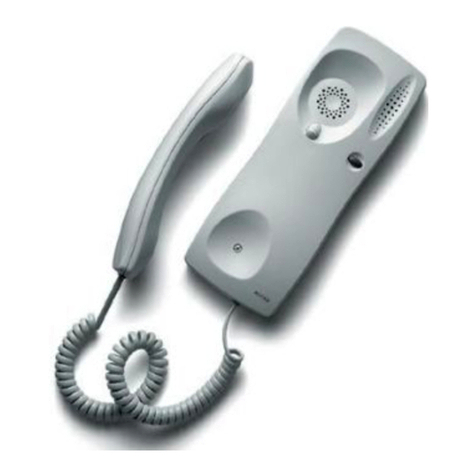
Alcad
Alcad 960 Series manual
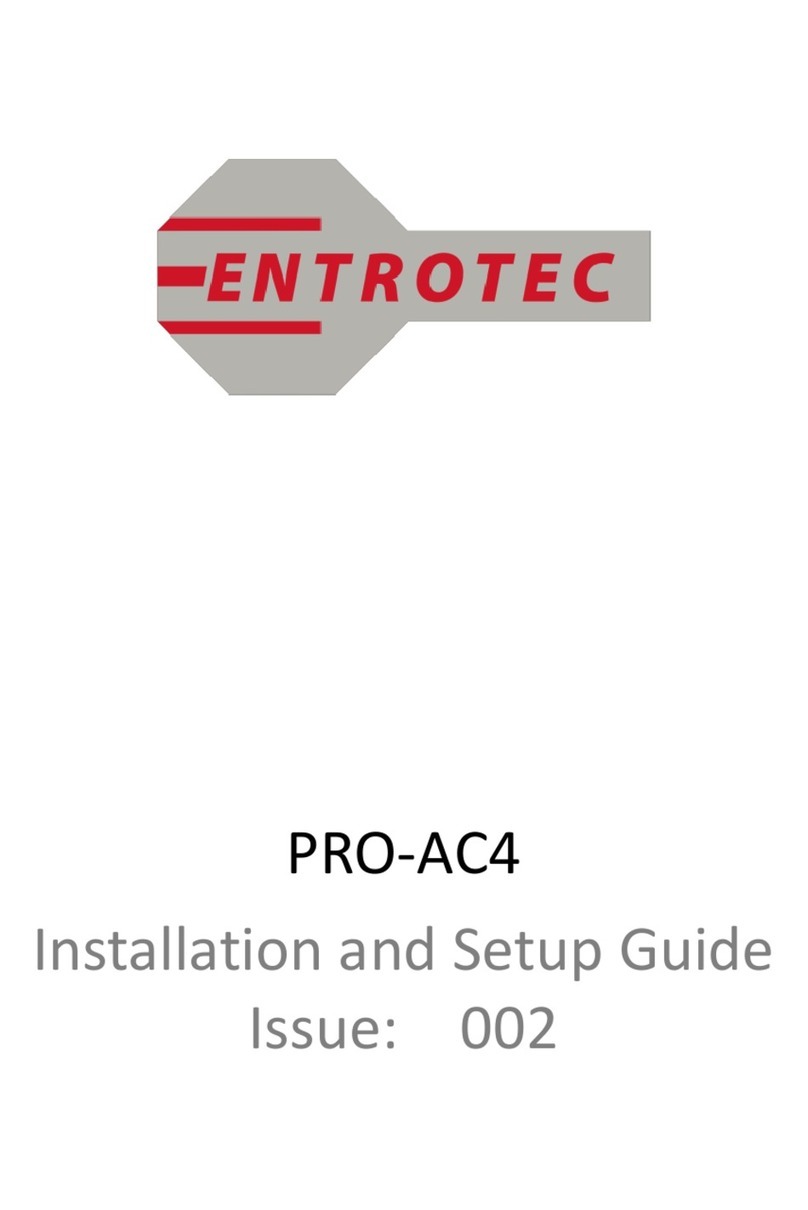
Entrotec
Entrotec PRO-AC4 Installation and setup guide
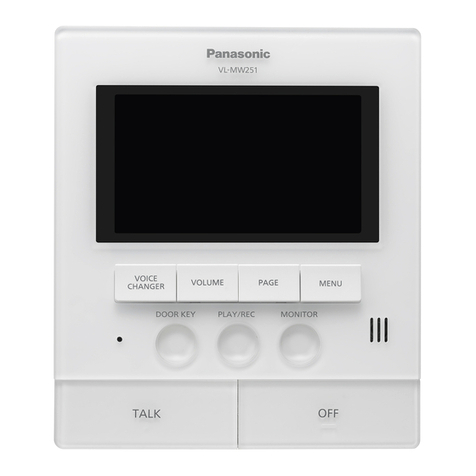
Panasonic
Panasonic VL-V900 installation guide
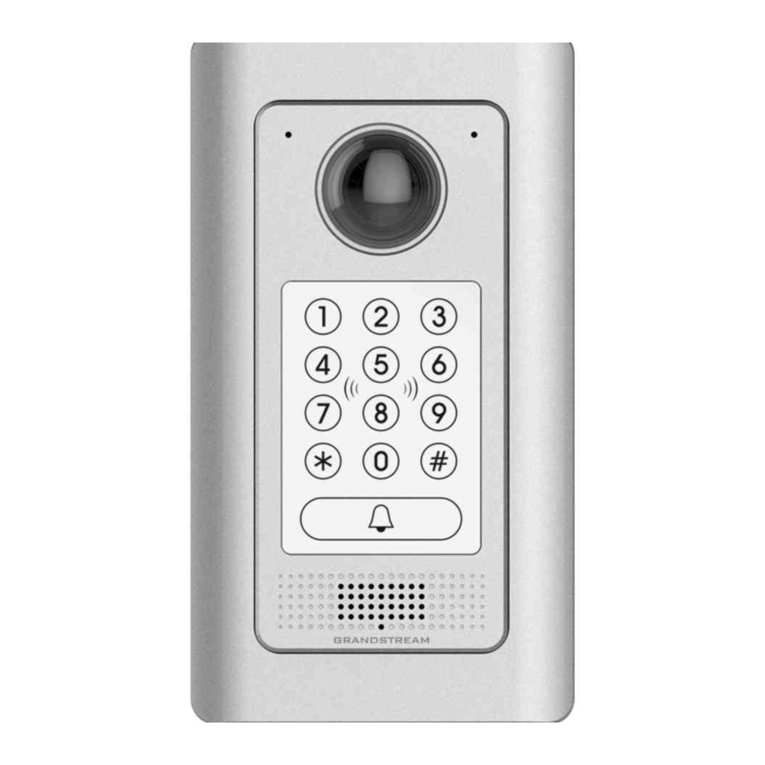
Grandstream Networks
Grandstream Networks GDS3710 Connection guide
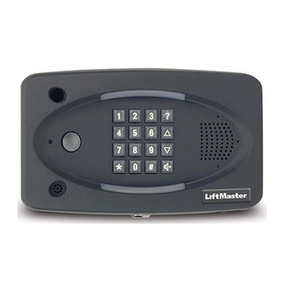
Chamberlain
Chamberlain LiftMaster ELITE EL25 installation manual
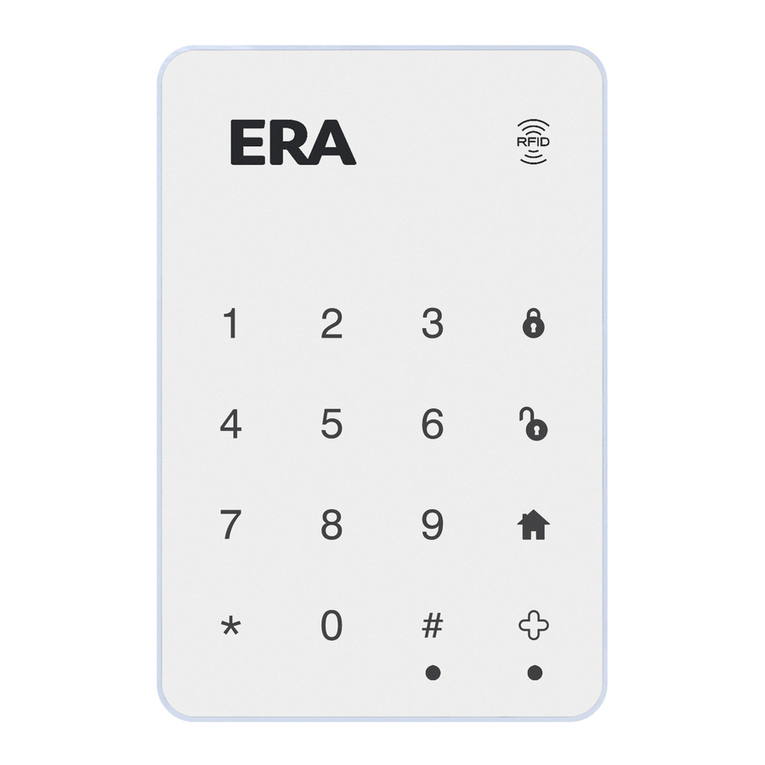
Protect
Protect ERA Installation and operating manual
